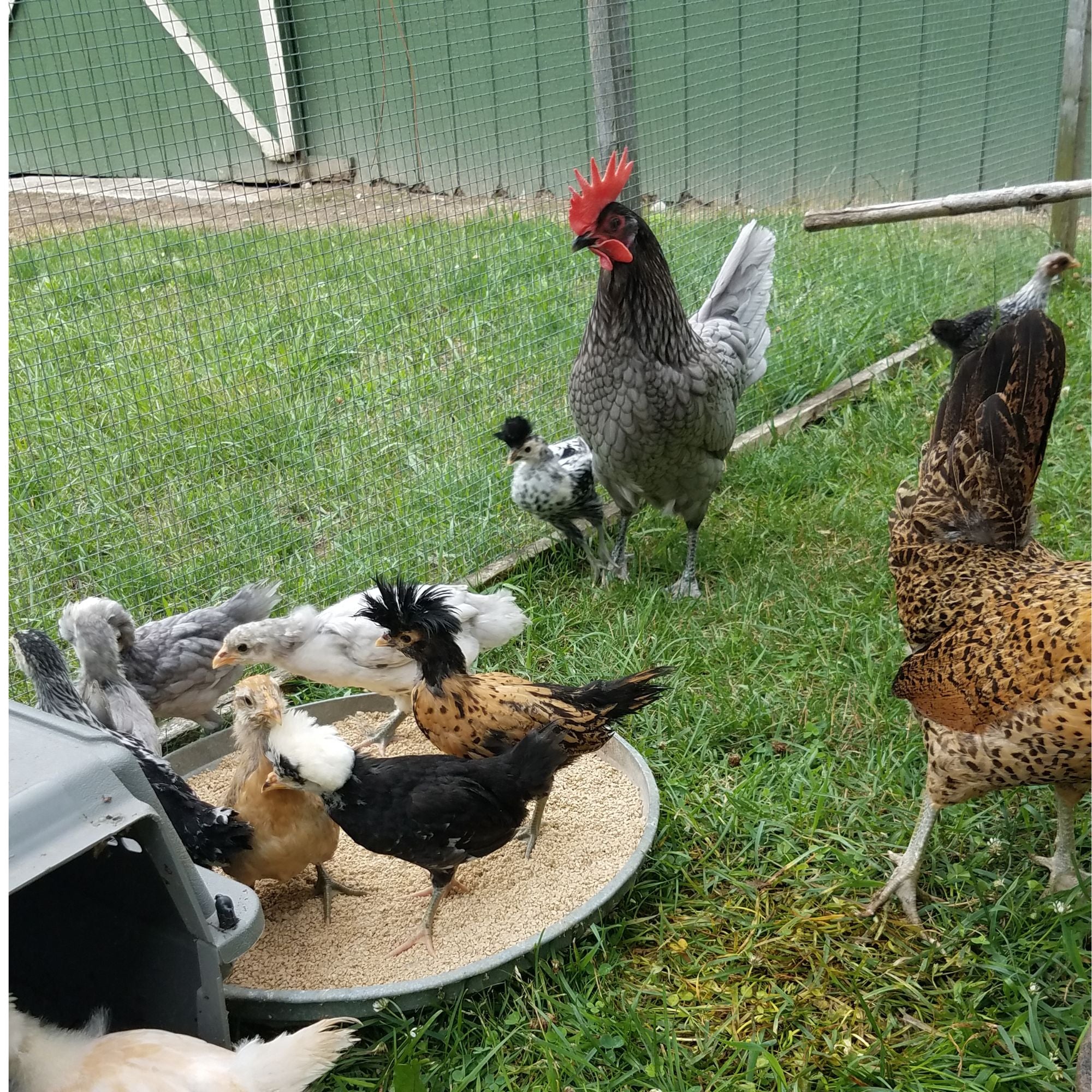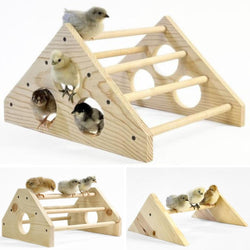How do I introduce new chickens into my old flock?
Back to blog
We get questions about this all the time! Let there be no doubt: adding new birds to your pre-existing crew can be stressful, both to you and the birds. Your flock, peaceful because every hen knows her place in the pecking order, will be thrown all out of whack by the addition of newcomers. Every hen and roo will once again have to vye for his or her spot on the pecking order. At times it can seem like all-out war! The good news: it only lasts about a week, and there are a few things you can do to make it much easier on all of you.
Two things to consider first, however.
You'll need to quarantine them for four weeks make sure they don't have any infections, latent illnesses or communicable health issues that the rest of your flock can catch. Even when you are buying adult birds from an individual or farm you trust, you must always quarantine simply because the stress of a new environment can cause the bird to get ill with something he or she had been previously fighting off - or it may be that the bird was ill but was not to the point, yet, of showing symptoms. It could also be that the person you purchase from just doesn't have eyes as good as yours, to catch things like avian lice or mites. Keeping them in another area first will have you waging a smaller battle than if you had to try to eradicate parasites from your entire flock. The quarantine is a good idea because if the new birds are ill, you can get a diagnosis and treat them while avoiding exposing your established flock to an illness! If you've bought brand new baby chicks from a reputable NPIP hatchery, quarantine isn't really something you need to worry about, but your new chicks will be in their brooder, separate, anyway for just as long.
You can also watch this YouTube videos ad to see additional tips and advice on quarantine:
Second, make sure the chooks you're introducing are old enough to defend themselves against the larger birds in your flock, certainly no sooner than 6 weeks.

"No sooner than 6 weeks, else we will END you, Outlander."
Cliques (or clucks?) of hens can be sort of like The Mean Girls in middle and high school. You have someone immigrating to the flock? As far as your established flock is concerned, the newcomer is a dangerous invader... so their instinct is to drive the newbies away. And they ain't gentle about it, you feel me? Birds can get seriously hurt. So don't just throw everyone in together--many chickenistas have learned the hard way... through tragedy.
The most important peace-making technique is to allow the birds to see one another, and even be in the same SPACE together, without having physical access to one another. This will allow them to work out the pecking order through subtler cues. If you have a run, you can achieve this by putting the new birds in the run with your old-timers but separating them with chicken wire, hardware cloth, or something else that'll do the same job. (Making sure, of course, that they all have access to food and water.) Do this for a week, or even two, before letting them in with the main flock.
After that first week, when you're ready to make the transition, some people advise that it's easiest to first introduce the new birds once they're all sleeping--the idea being that upon awakening your resident flock will notice the new guys but be too groggy to realize that things have changed, and/or too interested in eating to attack them right away. This doesn't seem to always be the case--some girls do notice immediately!--but morning introductions can't really hurt.
A few warfare-alleviating tactics we can say with certainty that reduce fighting all involve distraction. If your girls have nothing better to do they'll chase the poor newcomers and pick on them relentlessly. Distract them and you'll find they're much less mean. Tried and true distraction techniques include:
Two things to consider first, however.
One: If you've purchased adult or juvenile chickens (even from us!) or adopted a stray, plan to quarantine them for four weeks first.
You'll need to quarantine them for four weeks make sure they don't have any infections, latent illnesses or communicable health issues that the rest of your flock can catch. Even when you are buying adult birds from an individual or farm you trust, you must always quarantine simply because the stress of a new environment can cause the bird to get ill with something he or she had been previously fighting off - or it may be that the bird was ill but was not to the point, yet, of showing symptoms. It could also be that the person you purchase from just doesn't have eyes as good as yours, to catch things like avian lice or mites. Keeping them in another area first will have you waging a smaller battle than if you had to try to eradicate parasites from your entire flock. The quarantine is a good idea because if the new birds are ill, you can get a diagnosis and treat them while avoiding exposing your established flock to an illness! If you've bought brand new baby chicks from a reputable NPIP hatchery, quarantine isn't really something you need to worry about, but your new chicks will be in their brooder, separate, anyway for just as long.
You can also watch this YouTube videos ad to see additional tips and advice on quarantine:
Second, make sure the chooks you're introducing are old enough to defend themselves against the larger birds in your flock, certainly no sooner than 6 weeks.

"No sooner than 6 weeks, else we will END you, Outlander."
Cliques (or clucks?) of hens can be sort of like The Mean Girls in middle and high school. You have someone immigrating to the flock? As far as your established flock is concerned, the newcomer is a dangerous invader... so their instinct is to drive the newbies away. And they ain't gentle about it, you feel me? Birds can get seriously hurt. So don't just throw everyone in together--many chickenistas have learned the hard way... through tragedy.
Two: Learn the right way to manage chicken introductions.
The most important peace-making technique is to allow the birds to see one another, and even be in the same SPACE together, without having physical access to one another. This will allow them to work out the pecking order through subtler cues. If you have a run, you can achieve this by putting the new birds in the run with your old-timers but separating them with chicken wire, hardware cloth, or something else that'll do the same job. (Making sure, of course, that they all have access to food and water.) Do this for a week, or even two, before letting them in with the main flock.
After that first week, when you're ready to make the transition, some people advise that it's easiest to first introduce the new birds once they're all sleeping--the idea being that upon awakening your resident flock will notice the new guys but be too groggy to realize that things have changed, and/or too interested in eating to attack them right away. This doesn't seem to always be the case--some girls do notice immediately!--but morning introductions can't really hurt.
A few warfare-alleviating tactics we can say with certainty that reduce fighting all involve distraction. If your girls have nothing better to do they'll chase the poor newcomers and pick on them relentlessly. Distract them and you'll find they're much less mean. Tried and true distraction techniques include:
- Hanging a treat such as a half a head of cabbage just out of reach so the chickens have to jump to get at it, an odd but miraculous solution;
- Adding large branches to the run and even inside the coop if possible, making pursuit more difficult and giving the newcomer(s) a place to hide;
- Adding dead leaves, grass clippings, pulled weeds and/or table scraps to their run, giving them plenty to dig through;
- Making absolutely sure there is plenty of space on roosts, at waterers, at feeders and so on, so they don't have to compete;
- Rearranging the coop at the same time you introduce the birds. This more or less can help make the coop a more neutral area, because everyone will have to re-establish territories in the "new" space.











